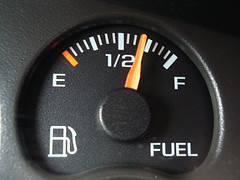 The U.S. Environmental Protection Agency (EPA) and the Department of Energy (DOE) today released the official 2011 Fuel Economy Guide, providing information about estimated mileage and fuel costs for model year 2011 vehicles sold in the U.S.
The U.S. Environmental Protection Agency (EPA) and the Department of Energy (DOE) today released the official 2011 Fuel Economy Guide, providing information about estimated mileage and fuel costs for model year 2011 vehicles sold in the U.S.
For the first time, the annual Fuel Economy Guide includes medium-duty passenger vehicles, generally large sport utility vehicles (SUVs) and passenger vans. These were not previously subject to fuel economy measurement and labeling requirements.
Listings in the 2011 Fuel Economy Guide provide an estimated annual fuel cost based on a vehicle’s MPG rating and national estimates for annual mileage and gas prices. The online version lets users input local gas prices and information about their normal driving habits to get a personalized fuel cost estimate.
The EPA and DOE will provide additional automobile fuel economy information online as more 2011 models, including electric cars— like the Chevy Volt, the Nissan Leaf— and plug-in electric hybrids become available.
The guide arrives as the Alliance of Automobile Manufacturers, a trade group including General Motors, Ford, Chrysler and nine others, has accused the EPA and National Highway Traffic Safety Administration (NHTSA) of setting unattainable goals for vehicles’ fuel efficiency by the year 2025.
The Detroit News reports:
“The NHTSA and EPA said they could propose anywhere from 47 mpg to 62 miles per gallon (MPG) by 2025, achieved by a range of 3 to 6 percent increases annually.
The agencies said the added costs per vehicle would range from $770 to $3,500 by 2025. The move could add $12 billion to $50 billion annually to the price of new cars.
But the automakers said the actual price could be 2 1/2 times higher, based on a National Research Council report. They said under some scenarios, consumers wouldn’t recoup the higher vehicle costs through fuel savings.”
In late October, the EPA and U.S. Department of Transportation released the first national standards to reduce greenhouse gas emissions from and improve fuel efficiency of heavy-duty vehicles including combination tractors, heavy-duty pickups and vans, and vocational vehicles (such as delivery trucks, dump trucks and buses).
Environmentalists and auto industry officials told Politico.com that they expect “conflict with the administration as government control of GM and Chrysler diminishes, especially when Republicans take over the House next year.”
On Tuesday, the Obama administration announced plans to reduce the government’s 61% stake in General Motors to 35% in the next few years, starting with a $10 billion stock offering Nov. 18th. The offering marks the probable end of an era when the U.S. government and auto industry collaborated extensively to save more than an estimated 1 million domestic auto-industry jobs.
With respect to the EPA, the President said in a post-election news conference on Wednesday:
“The EPA is under a court order that says [greenhouse gases] are a pollutant that fall under their jurisdiction…We need to not ignore the science [but] find ways to solve [environmental] problems in ways that don’t hurt the economy, that encourage the development of clean energy in this country, and give us the opportunity to create jobs [while] putting us in a competitive posture around the world.”
Image via: Chego101